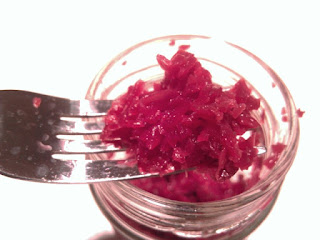Just yesterday I posted an article about how to make homemade yogurt using a homemade yogurt maker. So today I would like to talk about another fermented food that I eat often – sauerkraut.
I had never eaten (or even tasted) sauerkraut until I started the GAPS Diet. I’d heard a bit about sauerkraut in my adult life, but not much other than it’s something some people put onto a hot dog. Mostly I’d only seen it in the movies or references to hot dogs in New York. Well, I’m from the South and the only thing I’d ever put on my hot dog was chili, cheese, onions and mustard. OK…back to the purpose.
Sauerkraut made at home, just like a good homemade yogurt, is full of good bacteria (probiotics) to help heal the digestive system. Up to this point, I’ve only made two batches. My first batch included green cabbage, carrots, onions and garlic. When it was completed…the smell was, well, overwhelming to my senses and everyone else in the house. Yet, I still ate it because I needed it. But, for my second batch I decided to keep it simpler and only used red cabbage. The red cabbage sauerkraut was milder and less “smelly” and very good, might I add. My husband allows me to put in on his sandwiches. Therefore, this is my desired recipe for a simple sauerkraut.
1 medium size red cabbage
1 – 2 TBS of sea salt
Tools:
1 quart or 1/2 gallon size mason jar
A strong set of “clean” hands
Directions:
- Thinly slice the cabbage with a knife or use the slicing disc of a food processor. You might want to keep 1 large leaf for step 5.
- Put the cabbage into a big bowl that is large enough so that the cabbage doesn’t fill it to the rim.
- Add 1 – 2 TBS of sea salt and start kneading with clean hands.
- Continue kneading until you produce enough liquid so that when you pack into the jar, you will be able to push the cabbage beneath the liquid.
- Pack the mixture into the jar leaving only liquid on top and some space between the liquid and the top of the jar. If you reserved a leaf, you can place the leaf on top to keep the shredded cabbage from floating to the top. Hint: In my last batch I put in a smaller “baby food” jar on top to hold down the cabbage.
- Put the top onto the Mason jar, but not tightly. Just enough so that it will not fall off. You can then cover with a towel or a coffee filter secured with a rubber band to be sure that gnats or
smaller bugs do not try to get to it. Be sure that your sauerkraut can breathe and expand as needed. Although I didn’t have a problem with any bugs trying to get into sauerkraut. - Place inside of a dark cabinet on top of a bowl or plate that can collect any liquid which might escape during the fermentation process.
- Ferment for 3 – 7 days. (I’ve not taken note of this yet, but many say it will stop bubbling when fermentation has completed.)
- Place into refrigerator. You can eat immediately. Many agree it tastes best when given a week or two to mellow out before eating, but it can continue to “mellow” even while you are enjoying it. (Just remember to ALWAYS use a clean spoon when serving the sauerkraut.)
Sauerkraut will last for months as long as it’s refrigerated. I have usually remove what I will use for the week and put that amount into a smaller jar in order to preserve my larger batch.
Recipe for a sweeter sauerkraut:
1 head of purple cabbage
1 fresh whole pineapple, cored
1/3 to 1 cup of cilantro
2 – 3 green onion stalks OR 1/2 cup finely minced sweet onion
juice of 1 lime
1 TBS Sea Salt
Follow same directions as above. You can add the onion, lime juice and cilantro just before packing into jar.
“Sauerkraut…is commonly consumed in Germany, Russia and Eastern Europe. It is a wonderful healing remedy for the digestive tract full of digestive enzymes, probiotic bacteria, vitamins and minerals. Eating it with meats will improve digestion as it has a strong ability to stimulate stomach acid production.” (Dr. Natasha Campbell-McBride MD, Gut and Psychology Syndrome, p 196, United Kingdom: Medinform Publishing, 2011.)
www.realfoodanddrinks.com



